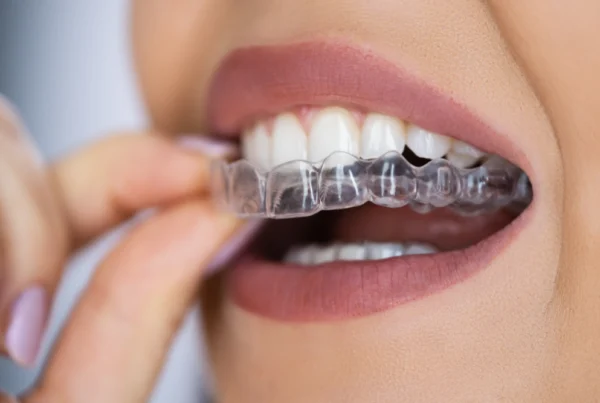Many people assume that missing teeth automatically means they can’t get clear aligner treatment. The truth is that modern clear aligners are much more adaptable than most people realize, and missing teeth don’t necessarily prevent you from achieving a straighter smile.
Clear aligners offer significant advantages over traditional braces when dealing with missing teeth. Unlike fixed braces, aligners can be designed specifically to account for gaps in your smile. This customization ensures proper fit while targeting movement of your remaining teeth effectively.
The appearance benefits are particularly important for people who already feel self-conscious about missing teeth. Since aligners are virtually invisible, you can improve your oral health and alignment without drawing additional attention to your smile during treatment.
Comfort is another major advantage with clear aligners when you have missing teeth. Aligners are smooth and don’t have brackets or wires that might irritate sensitive areas in your mouth. This is especially beneficial if you’re already experiencing discomfort from missing teeth.
Understanding the Impact of Missing Teeth
Missing teeth create a cascade of oral health problems that extend far beyond just appearance. Understanding these issues helps explain why addressing alignment becomes even more important when you have gaps in your smile.
When teeth are missing, the remaining teeth lose the support they normally get from their neighbors. This can cause adjacent teeth to tilt or drift into empty spaces, creating new alignment problems and areas where plaque can build up more easily.
The force distribution during chewing becomes uneven when teeth are missing. This puts extra stress on your remaining teeth and can lead to excessive wear, potential damage, or problems with your jaw joints over time.
Long-term absence of teeth can cause jawbone deterioration where tooth roots once stimulated bone maintenance. This bone loss can change your facial appearance and affect your ability to chew and speak properly as time goes on.
When Clear Aligners Are a Good Option
Not everyone with missing teeth is automatically a candidate for clear aligner treatment, but many people find they’re excellent options when certain conditions are met. The key is understanding what makes someone suitable for this approach.
Healthy gums form the foundation for successful clear aligner treatment. Your gums need to be strong enough to handle the gentle pressure that aligners apply to move teeth. Good gum health significantly improves your chances of treatment success.
The stability of your remaining teeth plays a crucial role in treatment effectiveness. These teeth act as anchors for the aligners, so they need to be firm and not damaged by decay or other significant dental problems.
The complexity of alignment needed also influences whether aligners are appropriate. Clear aligners work excellently for moderate adjustments but have limitations with more severe misalignment issues. Your orthodontist can evaluate whether your specific needs fall within the treatable range.
Situations Where Aligners Might Not Work
Some dental conditions can make clear aligner treatment ineffective or even potentially harmful. Understanding these limitations helps ensure you get the most appropriate treatment for your specific situation.
Advanced gum disease creates an unstable environment for tooth movement. The inflammation and bone loss associated with severe gum problems make it risky to move teeth with aligners. The movement could worsen the condition rather than improve your oral health.
Significant bone loss in your jaw can also prevent successful aligner treatment. Adequate bone density is essential for safe tooth movement, and without it, aligners cannot function reliably or safely.
How Aligners Prepare Your Mouth for Future Restorations
Clear aligners do more than just straighten teeth when you have missing teeth. They can strategically prepare your mouth for future restorative work like implants or bridges, creating the best conditions for successful tooth replacement.
Before placing implants or bridges, aligners can position your remaining teeth to create ideal spacing and alignment. This preparation ensures that future prosthetics fit properly and look natural within your smile while preventing potential complications.
During aligner treatment, temporary solutions like temporary teeth can be incorporated into your aligners. These temporary teeth maintain your mouth’s shape, support proper speech, and allow normal eating while preserving the appearance of a complete smile throughout treatment.
The entire process is carefully coordinated from start to finish, demonstrating how versatile clear aligners can be in comprehensive dental restoration plans.
Key benefits of using aligners to prepare for tooth replacement include:
- Strategic positioning of remaining teeth to create optimal space for implants or bridges
- Maintenance of proper mouth shape and gum contours during the preparation period
- Incorporation of temporary teeth within aligners to preserve function and appearance
- Coordination with other dental specialists to ensure seamless transition to final restorations
- Prevention of further tooth movement that could complicate future prosthetic placement
This comprehensive approach ensures that your alignment treatment works toward your ultimate goal of a complete, functional, and attractive smile.

Alternative Options When Aligners Aren’t Suitable
When clear aligners aren’t the best choice for your situation, several alternative orthodontic methods can effectively address gaps and alignment issues. These options provide flexibility to match treatment approaches with your specific needs.
Traditional braces remain a reliable option for complex alignment issues, including significant gap closures. The adjustable wires and brackets offer precise control over tooth movement, making them suitable for challenging cases where multiple teeth need repositioning.
Provisional bridges can provide immediate cosmetic and functional benefits for less severe gaps. These act as temporary placeholders, preventing adjacent teeth from shifting while maintaining your smile’s appearance during planning for permanent solutions.
Working with Your Dental Team
Successful clear aligner treatment with missing teeth may require coordination between different dental specialists. This collaborative approach ensures that every aspect of your care contributes to the best oral health and appearance outcomes.
Treatment begins with comprehensive examination of your current oral health status. This assessment identifies existing conditions, potential challenges, and determines the best strategic approach for your aligners. Understanding your specific needs allows for precise treatment planning.
Collaboration among orthodontists, gum specialists, and restoration experts ensures complete care throughout your treatment. Each specialist contributes expertise to make sure your aligner therapy complements future restoration steps like implants or bridges.
Continuous evaluation allows for adjustments to your aligners and treatment plan as needed. Monitoring how your teeth, gums, and jaw respond to treatment helps fine-tune the process for the best results.
At ReNEW Dental in Tewksbury, this coordinated approach ensures that patients with missing teeth receive comprehensive care that addresses both immediate alignment needs and long-term restoration goals.
What to Expect During Treatment
Understanding the clear aligner treatment process when you have missing teeth helps set realistic expectations and ensures better cooperation with your treatment plan. The process involves several important considerations specific to your situation.
Treatment planning becomes more detailed when missing teeth are involved. Your dentist maps out not just tooth movement but also how alignment will prepare your mouth for future restorations. This comprehensive planning ensures the best outcomes.
Regular monitoring becomes especially important with missing teeth cases. Your dental team tracks progress more closely to ensure alignment proceeds safely and effectively while maintaining the health of your remaining teeth and gums.
Essential aspects of clear aligner treatment with missing teeth include:
- Detailed treatment planning that coordinates alignment with future restoration needs
- Regular monitoring to ensure safe and effective tooth movement throughout the process
- Possible incorporation of temporary teeth within aligners to maintain function and appearance
- Coordination with other dental specialists for comprehensive care planning
- Ongoing adjustments based on how your teeth and gums respond to treatment
This thorough approach ensures that your clear aligner treatment addresses both your immediate alignment concerns and prepares your mouth well for any future dental work needed.
Your Path to a Complete Smile
Clear aligner treatment with missing teeth represents the evolution of orthodontic care toward more personalized, comprehensive approaches. The technology and techniques available today make it possible to address complex dental situations that were once considered untreatable with aligners.
The key to success lies in working with experienced dental professionals who understand how to adapt aligner treatment for unique situations. This expertise ensures that your treatment plan addresses both functional needs and appearance goals effectively.
Modern dentistry recognizes that each patient’s situation is unique and requires individualized solutions. Clear aligners can be part of comprehensive treatment plans that ultimately restore both function and appearance to your smile.
Ready to explore whether clear aligners could help prepare your smile for a complete restoration? Contact ReNEW Dental in Tewksbury today to discuss your options and learn how modern aligner technology could work for your specific situation.
ReNEW Dental
978-451-1500
1201 Main St. Tewksbury, MA 01876
Schedule your consultation today!
Frequently Asked Questions
Can I use clear aligners if I have missing teeth?
Yes, modern clear aligners are designed to be adaptable to missing teeth situations. With customized treatment planning, aligners can effectively prepare your mouth for tooth replacement options like implants or bridges while aligning your remaining teeth.
Will clear aligners affect the health of my remaining teeth?
Clear aligners actually benefit your remaining teeth by preventing further shifting and misalignment. They’re designed with gum health in mind and can be part of comprehensive oral health approaches that prepare your teeth for future prosthetics.
Is treatment with clear aligners more complicated with missing teeth?
Treatment becomes more personalized when missing teeth are involved, with care adapted to your specific situation. While it may involve additional steps like temporary pontics or implant planning, the process is designed for smooth progression toward excellent results.




